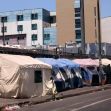California Governor Gavin Newsom has called on cities and counties across the state to adopt a sweeping ban on homeless encampments, intensifying his administration’s efforts to address the state’s homelessness crisis. On Monday, Newsom released a model ordinance for local governments, urging them to prohibit camping on public property, including sidewalks, bike paths, parks, and roadways.
“There are no more excuses,” Newsom said in a statement accompanying the ordinance. “Local leaders asked for resources — we delivered the largest state investment in history. They asked for legal clarity — the courts delivered. Now, we’re giving them a model they can put to work immediately, with urgency and humanity, to resolve encampments and connect people to shelter, housing, and care.”
The ordinance, which Newsom cannot force cities to adopt, coincides with the release of $3.3 billion in state-controlled funding for homeless services, including housing and mental health treatment. The money comes from a $6.4 billion state bond approved by voters last year and is intended to help local governments create the shelter capacity needed to comply with the new restrictions.
Under the model ordinance, it would be illegal to “construct, place or maintain on public property any semi-permanent structure” and to camp on public property for more than three consecutive days or nights within 200 feet of a single location. It also bans sitting, sleeping, lying, or camping in public spaces in a manner that impedes public passage. Cities would have discretion over the severity of penalties, ranging from citations to arrests, though the ordinance itself does not specify criminal penalties.
Critics argue that Newsom’s plan criminalizes homelessness and fails to address the root causes of the crisis, including the state’s severe housing shortage and high cost of living. Advocates for homeless people, including the National Homelessness Law Center, have condemned the approach, comparing it to policies championed by former President Trump. “Sadly, Newsom and Trump are using the same failed playbook,” said Jesse Rabinowitz, a spokesman for the group speaking to the New York Times. “We won’t be duped by this backwards approach, and we will continue to push for real solutions to homelessness, like housing and services.”
Supporters of the crackdown, however, argue that it reflects the frustrations of many Californians who have grown weary of encampments overtaking public spaces. Recent polling by Politico and the Jack Citrin Center for Public Opinion Research at the University of California, Berkeley, found that nearly 40 percent of California voters, including many Democrats, support arresting homeless people who refuse shelter, despite the political risks of such a hardline approach.
Meanwhile, local officials have expressed mixed reactions to Newsom’s push. Some, like Long Beach and Fresno, have already adopted tough anti-camping laws, while others, including Los Angeles Mayor Karen Bass, have favored voluntary approaches that emphasize housing and services over enforcement. Bass has touted her “Inside Safe” program as a more compassionate alternative, noting that it has helped achieve the first double-digit drop in street homelessness in Los Angeles in nearly a decade.
The new push to clear encampments could invite a wave of legal challenges, particularly in light of recent Supreme Court rulings that have given cities more leeway to penalize people for sleeping in public. Civil rights advocates argue that such measures could still be vulnerable to legal attack if they are not paired with sufficient shelter capacity, potentially exposing cities to costly lawsuits.
Despite these concerns, Newsom’s administration appears determined to push forward, arguing that the combination of new funding, legal clarity, and a clear policy framework will enable cities to tackle a crisis that has frustrated Californians for years.
“This is a starting point that jurisdictions may build from,” the administration’s guidance notes, adding that the model ordinance draws from strategies the state has used since 2021 to clear more than 16,000 encampments and remove hundreds of thousands of cubic yards of debris from public spaces.






